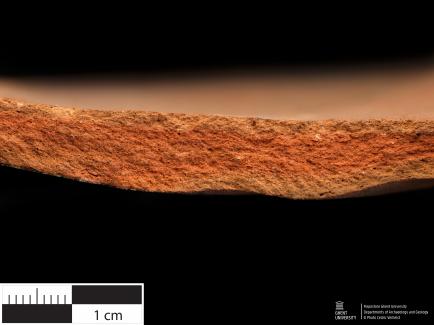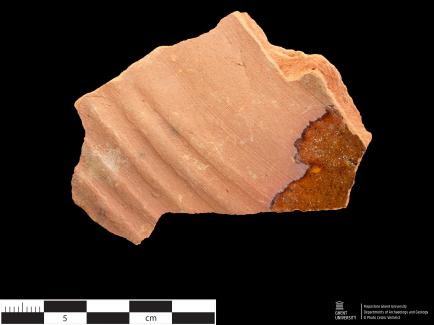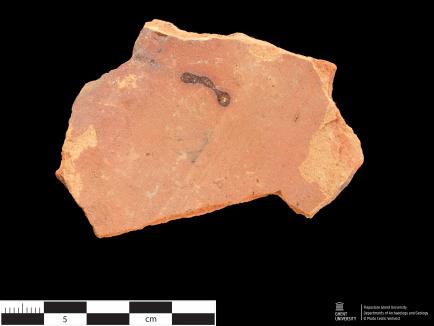Medieval - Red oxidized ware: lead glazed (6.ROLG.BE.0011)
Hand specimen pictures (macro & binocular)
Thin section pictures
Find location
- Category
- Red oxidized ware: lead glazed (Medieval)
- Fabric name
- Chronology
- Medieval > Late Medieval > 14-15th century CE
- Dating method(-s)
- typology, coin finds
- Potters' mark
- No
- Additional information
- wall fragment
Find location
- Site type
- Pottery production
- Location
- Belgium; Antwerpen; Antwerpen
- Site name
- Antwerpen, Korte Riddersstraat
- Excavation or Survey Team
- Oost T. & Ackermans J.; excavation in collaboration with Antwerpse Vereniging voor Bodem- en Grot onderzoek
- Additional contextual information
- excavation 1987; several pits with production waste were documented, contextual information: "put IX"
- Slip
- No
- Slip color
- Glaze
- Yes
- Glaze type
- lead glaze
- Glaze color
- orange brown
- Glaze additives
- Additional information
- splashed glaze
- Surface color
- light orange
- Surface texture
- Smooth
- Fracture color
- orange
- Inclusions (non-plastics/tempering)
- quartz (same rare grains up to 1 mm), rare black inclusions
- Matrix and voids
- small vesicles and rare vughs
- Diagnostic features
- Additional information
- sample ANTW_KR_ST1b
- Flepostore inventory nr.
- ARCH1.L1.C5b
- Original inventory nr.
- A0046
- Collection
- Archaeological Department, Ghent University
- Type
- Covered thin section
- Comparable thin section(s)
- Matrix
-
Oxidised orange-red fabric; brown (PPL), dark brown (XP).
Semi-heterogeneous matrix, non-calcerous with low optical activity.
- ca. 45-60% - Inclusions
-
Quartz (++; mono++, poly--, weathering and alteration), sedimentary rock detritus (-; quartz arenite, weathering and alteration), chert/flint (-), metamorphic rock detritus (-, low grade), feldspars (--; plagioclase, microcline, weathering and alteration), muscovite mica (++; el), O/Fe (+).
The coarse fraction consists of medium sand, the fine fraction consists of very fine to fine sand. Grains are generally rounded to subangular. Overall the fabric is poorly sorted and poorly orientated, single to double spaced.
- ca. 30-40% - Voids
-
Many small planar/channel voids and few vughs, well aligned, no infill.
- ca. 10-15% - Diagnostic features
- The fabric is characterized by a semi-heterogeneous oxidised matrix with low optical activity and moderately porosity. Dominant quartz and muscovite mica inclusions with frequent opaques/iron oxides, few sedimentary and metamorphic rock detritus and chert/flint, and rare feldspars. Overall poorly sorted fabric.
- Additional information
- Partial slip on outer exterior, translucent in PPL.
- Sample type
- Pottery
- Inventory number
- 6.ROLG.BE.0011
- Collection
- Archaeological Department, Ghent University
- Donating institute/person
- Onroerenderfgoeddepot, Stad Antwerpen
- Host collection
- Onroerenderfgoeddepot, Stad Antwerpen
- Other samples available
- Yes
- Sample collection method
- Archaeological Excavation
Oost & Ackermans 1988a
- Full reference
-
Oost T. & Ackermans J. 1988. Middeleeuwse pottenbakkersafval opgegraven aan de Korte Ridderstraat. In: De Landtsheer G. (Ed.). Cultureel Jaarboek Stad Antwerpen 1987. Antwerpen: 37-39.
Oost & Ackermans 1988b
- Full reference
-
Oost T. & Ackermans J. 1988. Bakken en misbakken: middeleeuwse pottenbakkersafval aan de Korte Ridderstraat te Antwerpen. Archaeologia Mediaevalis 11: 14-15.
Cite this page as: Flepostore - https://flepostore.ugent.be/ceramics/6-rolg-be-0011
Last modified: 2024-04-29.





